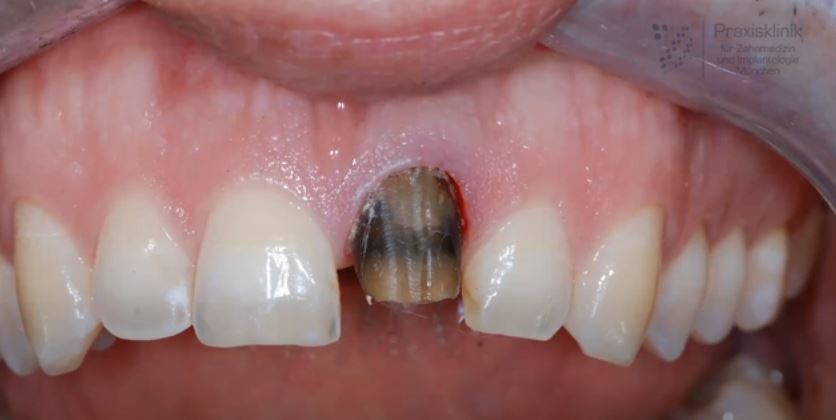If you’ve had a root canal, you’re familiar with the relief it provides from tooth pain. However, you might notice that your treated tooth has turned a darker color week or months after the procedure. This can be frustrating, but understanding the cause of the discoloration is the first step toward restoring your smile.
What Causes the Color Change After a Root Canal?
While a root canal effectively removes infection and alleviates pain, it can sometimes lead to cosmetic changes in your tooth’s appearance. A tooth that was once bright and white can turn brown, yellow, or even grey. But why does this happen?
The root canal treatment involves removing the pulp, which contains nerves and blood vessels, from inside the tooth. The absence of the pulp causes the tooth to lose its natural nutrients and oxygen supply, which can result in discoloration over time.
Understanding Root Canal Discoloration
Once the pulp is removed, the tooth loses its blood supply, similar to a plant that wilts when it is no longer watered. Without sufficient nutrients and oxygen, the tooth gradually darkens, sometimes becoming visibly discolored weeks or months after the treatment.
Other Contributing Factors: Leftover Pulp and Filling Materials
In some cases, leftover pulp tissue may remain inside the tooth. Even small amounts of dead tissue can break down and cause the tooth to darken. Additionally, the materials used to fill the root canal, such as gutta-percha, may contribute to the color change over time, much like how paint can change as it dries.
Table: Key Reasons for Tooth Discoloration After a Root Canal
| Cause | Description |
|---|---|
| Dead Pulp Tissue | Leftover tissue from the nerve and blood vessels inside the tooth can darken, leading to discoloration. |
| Filling Materials | Materials like gutta-percha used to fill the root canal can darken over time, affecting the tooth’s color. |
| Loss of Blood Supply | The absence of the tooth’s natural blood flow can result in a darker hue as the tooth no longer receives oxygen and nutrients. |
| Medications Used | Some medications used during the root canal process may contribute to discoloration. |
| Amalgam Fillings | Amalgam fillings can cause a bluish-gray tint, especially in visible teeth, due to their silver composition. |
The Role of the Tooth’s Blood Supply
Blood vessels are essential for maintaining a healthy, bright tooth. They supply oxygen and nutrients, keeping the tooth strong and vibrant. After a root canal, the tooth no longer has access to these vital resources, which can cause it to darken over time, much like a flower wilting without sunlight.
Medications and Discoloration

Some antibiotics and medications prescribed after a root canal to prevent infection can also contribute to discoloration. Even with proper oral hygiene, certain chemicals used during treatment may cause the tooth to become darker over time.
Amalgam Fillings: A Double-Edged Sword
Amalgam fillings, which were commonly used for root canal treatments, are effective but can sometimes cause a bluish-grey tint, particularly in visible teeth. This can be a concern for patients who want to maintain an aesthetically pleasing smile.
The Good News: Solutions for Tooth Discoloration
Although discoloration after a root canal can be concerning, there are several treatments available to restore the appearance of your tooth. Options such as internal bleaching, porcelain veneers, and crowns can significantly improve the tooth’s appearance.
Internal Bleaching: A Solution for Darkened Teeth
Internal bleaching is a great option for patients with discolored teeth after a root canal. This process involves applying a bleaching agent inside the tooth to lighten it from within. The results are often very effective, with noticeable improvement after just one treatment.
Porcelain Veneers and Crowns: Cosmetic Solutions
For teeth with severe discoloration, porcelain veneers or crowns are excellent restorative options. Veneers cover the front of the tooth, while crowns cover the entire tooth, effectively concealing any staining and restoring the tooth’s natural appearance.
What to Do Next: Consult Your Dentist
If you notice your tooth has darkened after a root canal, don’t worry. There are several treatments available to restore the natural appearance of your tooth. Visit your dentist or endodontist to discuss your options, including internal bleaching or restorative crowns, to brighten your smile once again.
Restoring Your Smile
Recent advancements in dental procedures and materials have made it easier than ever to treat discoloration after a root canal. Whether through internal bleaching, crowns, or veneers, you can restore the appearance of your treated tooth and enjoy a bright, healthy smile once again.
By working with your dentist and exploring the best options for your situation, you can maintain both the health and appearance of your smile long after your root canal treatment.
For more information about treatments and techniques, visit a trusted dental provider.
